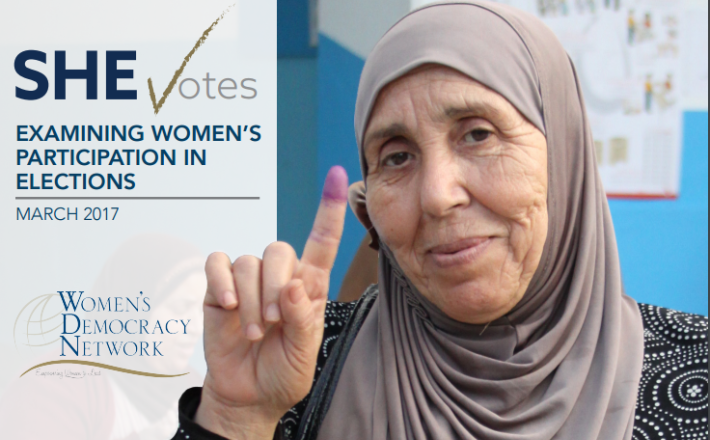SheVotes: Examining women's participation in elections
Despite women comprising nearly half of the world’s population, they continue to be drastically underrepresented in political leadership positions around the world. In fact, most have little or no access to the very decision-making tables where the policies are made that govern their lives.
Unfortunately, there is no one-size-fits-all model when it comes to designing and implementing successful women’s empowerment programs related to political participation. All too often the focus in this sphere centers on election data, such as turnout of women voters, how many women competed as candidates, and how many women obtained seats. However, the barriers to women’s progress in this field are complex, and successful interventions must take into account the holistic nature of the issue.
[[{"fid":"12213","view_mode":"default","fields":{"format":"default","field_file_image_alt_text[und][0][value]":"shevotes","field_file_image_title_text[und][0][value]":""},"type":"media","link_text":null,"attributes":{"alt":"shevotes","style":"display: block; margin-left: auto; margin-right: auto;","class":"media-element file-default"}}]]
Based on its experience conducting gender assessments of elections throughout the world, as well as a review of external research and analysis of women’s participation in elections, IRI has developed a framework for this assessment based on a three-part typology of barriers. Individual barriers impede women’s self-efficacy and empowerment. Government barriers include legislative and regulatory provisions that undermine—through omission or commission—women’s participation. Societal barriers include norms of patriarchy or misogyny that exclude women from participating fully in the public sphere. These three types of barriers can exist in isolation and have discrete effects on women’s political participation. However, they are more often mutually constitutive and reinforcing. For example, electoral rules that fail to explicitly protect women’s access to political and electoral processes often indicate deeply embedded social norms of patriarchy. Therefore, the barriers to women’s political participation in any society are often multidimensional, reflecting the complex interaction of cultural values and institutional rules. Consequently, overcoming these barriers necessitates not simply encouraging women to overcome them, or even changing laws and practices, but also transforming the gender norms that undergird them.
Click here to access the study.

Despite women comprising nearly half of the world’s population, they continue to be drastically underrepresented in political leadership positions around the world. In fact, most have little or no access to the very decision-making tables where the policies are made that govern their lives.
Unfortunately, there is no one-size-fits-all model when it comes to designing and implementing successful women’s empowerment programs related to political participation. All too often the focus in this sphere centers on election data, such as turnout of women voters, how many women competed as candidates, and how many women obtained seats. However, the barriers to women’s progress in this field are complex, and successful interventions must take into account the holistic nature of the issue.
[[{"fid":"12213","view_mode":"default","fields":{"format":"default","field_file_image_alt_text[und][0][value]":"shevotes","field_file_image_title_text[und][0][value]":""},"type":"media","link_text":null,"attributes":{"alt":"shevotes","style":"display: block; margin-left: auto; margin-right: auto;","class":"media-element file-default"}}]]
Based on its experience conducting gender assessments of elections throughout the world, as well as a review of external research and analysis of women’s participation in elections, IRI has developed a framework for this assessment based on a three-part typology of barriers. Individual barriers impede women’s self-efficacy and empowerment. Government barriers include legislative and regulatory provisions that undermine—through omission or commission—women’s participation. Societal barriers include norms of patriarchy or misogyny that exclude women from participating fully in the public sphere. These three types of barriers can exist in isolation and have discrete effects on women’s political participation. However, they are more often mutually constitutive and reinforcing. For example, electoral rules that fail to explicitly protect women’s access to political and electoral processes often indicate deeply embedded social norms of patriarchy. Therefore, the barriers to women’s political participation in any society are often multidimensional, reflecting the complex interaction of cultural values and institutional rules. Consequently, overcoming these barriers necessitates not simply encouraging women to overcome them, or even changing laws and practices, but also transforming the gender norms that undergird them.
Click here to access the study.